Site menu:
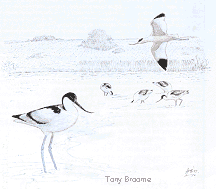
July 2017 Newsletter
Black Tern Spring Passage 2017.
Colour Ring Report.
June Bird News.
Forthcoming Events.
Latest Newsletter.
Black Tern Spring Passage 2017.

The spring passage of Black Terns on the Dee Estuary and North Wirral coast this year was the best since the record year of 1990. To put the 2017 passage in perspective over the 27 years since 1990 there were nine years when none were seen at all in spring, and only in one other spring were records in double figures, which was in 2016.
The two bar charts below show spring records from the Dee estuary (1990 to 2017), and the North-west of England as a whole (2008 to 2017) for comparison. It is worth noting that in 1990 far more birds were seen inland of the Dee Estuary both in Cheshire and Flintshire including several three-figure flocks - 1990 was by far the largest passage of Black Terns ever recorded in our area (and probably in the country as a whole). It is clear that the 'normal' number of spring records for the Dee Estuary is less than ten and often zero.
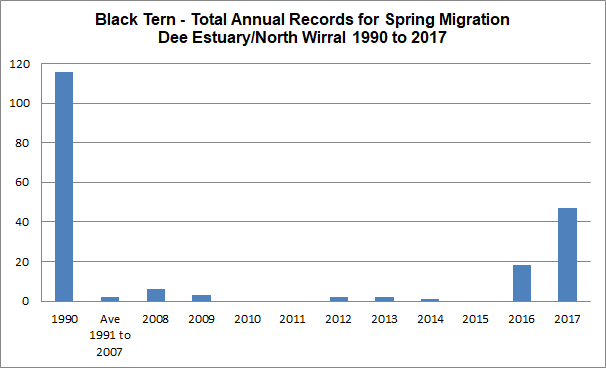
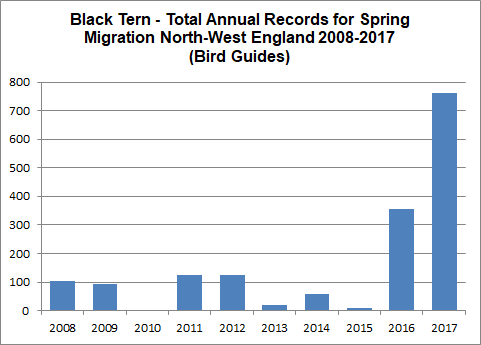
This year, 2017, birds were seen along the coast off North Wirral and Hilbre, as well as at the head of the estuary at Connah's Quay, Shotton and Burton Mere Wetlands. This is interesting as in 1990, despite an estimated total of at least 600 birds recorded in inland Cheshire, not a single one was seen along our coastline (in 1990 most Dee Estuary birds were recorded at Inner Marsh Farm with max count of 70). This is obviously a clue to the route they had taken to get here and there was certainly some evidence in 1990 that they took an inland route and came up through the country heading north-west after crossing the English Channel from France having been deflected from their normal route by adverse winds. In contrast, in 2017 it would seem likely that at least some birds came up the Irish Sea and good numbers flying into Morecambe Bay off the sea, heading north-eastwards/eastwards, would seem to confirm that. Trying to establish the exact route they take is difficult as very few terns of any species are recorded flying up the Irish Sea, somewhat surprising when you consider the many thousands of Arctic, Common and Sandwich Terns which must be migrating north to nest in Anglesey, Shotton, Seaforth etc., as well as those known to cross the country from Morecambe Bay to the North-East of England. They just seem to arrive unseen, either at their colonies or when they make landfall along the Liverpool Bay coast and Morecambe Bay. Probably they either fly very high, at night, or well away from land, or a combination of those. I know during this 2017 influx sea-watchers on Bardsey Island were busy looking for Black Terns but didn't see a single one.
Whatever route they arrive here at the Dee estuary where do the Black Terns come from and where are they going?
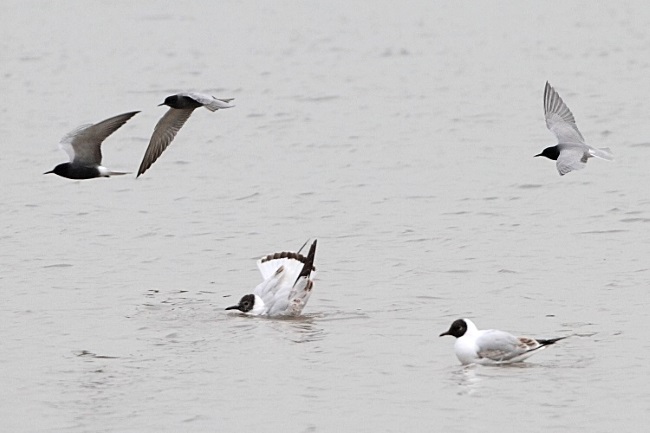
Black Tern Migration.
Black Terns are unusual in as much they are a marsh tern (such as White-winged Black Terns and Whiskered Terns) during the breeding season whilst in winter they are a maritime tern (such as Common Terns and Sandwich Terns), and most spend much of the winter far off-shore along the west coast of Africa. In contrast the other marsh terns winter inland or along coastal lagoons.
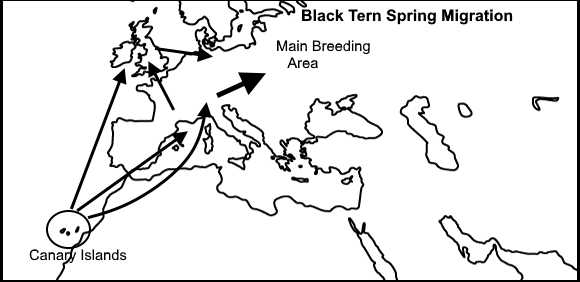
When spring comes they head north and there is a major staging area around the Canary Islands where they spend several days in April. From the Canary Islands the majority of birds use a route which takes them through the western Mediterranean to northern Italy and overland to their breeding grounds with the majority breeding in eastern Europe and Russia, there are smaller numbers breeding in western Europe including the Netherlands. The precise cause of the influxes into the UK has been the subject of much debate over the years, but is obviously largely influenced by the weather patterns as the birds fly north. It seems likely that easterly and north-easterly winds over Spain, France and/or the Bay of Biscay deflect the birds westwards form their normal route.
Juana and Garcia (2015) give a very interesting description of the spring passage in Iberia, stating that birds are observed both flying east through the Strait of Gibraltar and also along the south-western coast, I quote:
The spring passage is comparatively rapid and more concentrated than the autumn movements. Once again occurrences tend to be irregular but large numbers are seen at times. Influxes occur in some years on southwestern coasts, especially in Cadiz and Huelvas and also in the Strait (of Gibraltar) where the birds are usually flying east. Whereas autumn movements most often involve a leisurely succession of small groups those seen in spring are more likely to be in large compact flocks moving rapidly onwards. For example, Stead (1959) had two to three thousand in view at once moving east off Tarifa on 25 April 1958 and Nisbet et al. (1961) saw ‘many thousands' arriving from the sea on the Donana coast in May 1956. Such observations imply the existence of a large offshore passage northwards up the Moroccan coast (BM).
Looking back at accounts of previous influxes into the UK two things are apparent, the influxes often come in two or more waves, and each wave passes through quickly with individual birds lingering no more than a day or two. In 2017 the first wave were birds cutting across south-east England, just north of London, on April 25th. The second wave was on April 30th to May 2nd, and this was far more widespread and included those we saw here on the Dee estuary. The waves indicates that they are birds travelling in large numbers together, perhaps leaving the Canary Islands at the same time. Two waves may well mean that they arrived in the UK from two different directions with, perhaps, one lot travelling overland and the other over the sea. I've already mentioned that the Black Terns arrived in 2017 on the Dee estuary coast and along the coast up to Morecambe Bay with no observations of their flight up the Irish Sea, but the same applied inland with birds appearing en masse over inland waters in the Midlands on April 30th and May 1st with virtually no records of them further south. Again, this implies they are travelling overnight/and or flying high before deciding to drop down to feed on the various reservoirs of the Midlands.
I end this article with an extract from Mark Turner's article 'Black Terns Influx, Spring 1990' printed in the 1990 Cheshire and Wirral Bird Report:
From dawn onwards on May 2nd Black Terns amassed at many locations...... On the major waters, the pattern seemed to be consistent. Birds would either arrive or already be present at dawn and numbers would be supplemented by further arrival throughout the afternoon and early evening. Then the terns would wheel up high and depart to the north or north-east leaving just a few stragglers behind. Black Terns were present at virtually every significant inland water in Cheshire and in record numbers!
Sources of Information
1. Cheshire & Wirral Bird Reports various 1973 to 2015, CAWOS.
2. Clwyd Bird Reports and North-East Bird Reports, various 1980 to 2015, Clwyd Bird Recording Group.
3. British Birds - accounts of large Black Tern passages in 1948, 1949, 1950 and 1954.
4. All those who have contributed with Black Tern records in www.deeestuary.co.uk.
5. Bardsey Bird Observatory (thanks to Steve Hinde pers. comm.).
6. BirdGuides.
7. BTO Migration Atlas, 2002.
8. Birds of the Western Palearctic, BWPi - Interactive version (2003 - 2006).
9. S. Delany et al., Black Tern section
of 'Urgent preliminary assessment of ornithological data relevant
to the spread of Avian Influenza in Europe' (2006), Report to
European Commission.
10. J. Winden et al., Idiosyncratic Migration of Black Terns (Chilodonias niger): Diversity in Routes and Stopovers, Water birds 37(2):162-174 (2014).
11. Eduardo de Juana & Ernest Garcia, The Birds of the Iberian Peninsula, Bloomsbury (2015), extract taken from "The Birds of the Iberian Peninsula - Page 387 - Google Books Result".
12. Mark Turner, Black Terns Influx Spring 1990, Cheshire & Wirral Bird Report 1990, CAWOS.
Richard Smith
Top of PageColour Ring Report
Three colour-ringed waders in this month's report all showing some
interesting movements. Firstly an Avocet which is the first
colour-ringed one reported for many years, our first ever colour-ringed
Ringed Plover and same late feedback for a Black-tailed Godwit recorded
by us last October.
Avocet
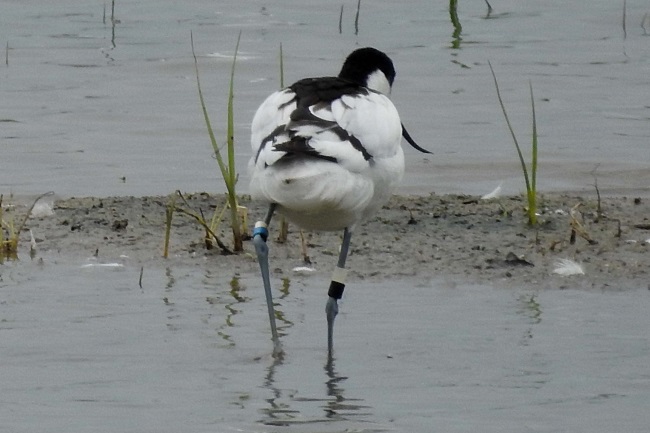
Recorded at Burton Mere Wetlands on May 18th 2017.
Being in it's first year this is a non-breeding bird, Avocets start breeding in their second or third year. Having been hatched on the north-east coast of England it is interesting that it was on the north-west coast in late spring, but not unexpected as the young birds do disperse widely and more often than not do not return to their natal site when they do start breeding - so perhaps next year WB-WN will breed at Burton Mere Wetlands.
Ringed Plover

/Yflag108-B Ringed as a breeding female in a Dundee supermarket car park on June 17th 2016 (and present there until July 11th).
Recorded at Hilbre on June 13th 2017.
We always love getting feedback from the ringers and Chris McGuigan's was particularly interesting:
Presumably, given the time of year, this bird was taking a year off from breeding. This is something relatively long-lived birds can do although it is not often we get the evidence. It will be interesting to see if it returns to Dundee next year.
Black-tailed Godwit
YOL-GYG
- ringed as an adult male on the Alde River, Suffolk on August 26th
2011.
On
returning from breeding in Iceland this bird undergoes moult in the SE
of England (usually the Stour Estuary) where it was recorded in summer
and early autumn in 2012, 2014, 2015 and 2016. It then moves north-west
across the country to the Dee estuary (Gilroy and Thurstaston) where it
was recorded in the autumn of 2011, 2013, 2014 and 2016. We often see a
distinct movement of birds moving west from the Wash to the Dee in
October and November (this was particularly noticeable in 2016) so
presumably this was part of the same movement. There are NO records in
December or January, perhaps it keeps on moving west and spends
mid-winter in Ireland as some are known to do. Late winter and
spring records are also very
scarce but it was on Thurstaston shore in February 2012, and March 2017
saw it on the Ribble estuary.
Richard
Smith.
Colour-rings were also reported by Matt Thomas, Les Hall and Steve
Hinde.
June Bird News

As you would expect in June it was a fairly quiet month. but not without much interest. The weather was somewhat mixed and periods of strong winds brought a max of 78 Gannets off Hilbre and at least 10 Manx Shearwaters off Point of Ayr, plus a handful of sightings of both Great and Arctic Skuas.
Five Whimbrels were at Gronant on the 2nd, presumably on their way north, yet by the 24th four had returned to Heswall - presumably non or failed breeders. There were plenty of signs of other birds returning from breeding including several reports of Mediterranean Gulls and Sandwich Terns, as well as Redshank, Curlew and Black-tailed Godwits.
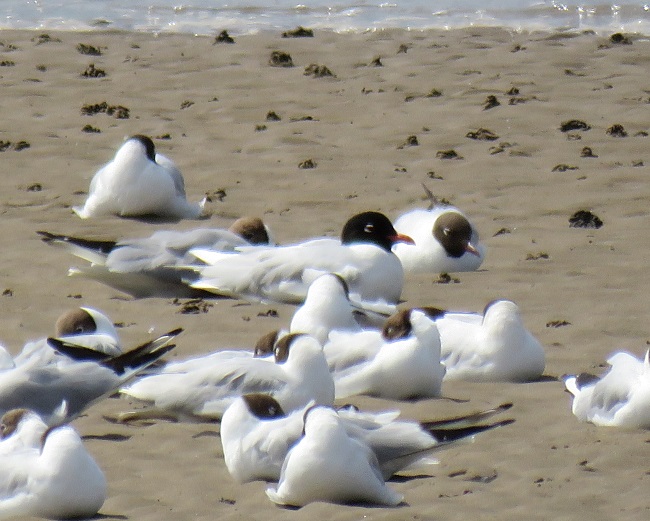
Two or three Marsh Harriers
continue to be reported on the marshes and I see the RSPB now say there
was a maximum of 11 over-wintering last winter - a remarkable number
but not as high as some were claiming. There were also three reports of
over-flying Red Kites through the month.
At least two Great White Egrets and up to three Spoonbills spent the month around the estuary. At the time of writing there is still one young Cattle Egret remaining on the nest at Burton Mere Wetlands and it is expected to fledge in the next few days. I've managed to obtain quite a lot of other breeding bird info which I summarise as follows:
Little Terns: The number of pairs breeding at Gronant has increased yet again from last year's record of 141 to about 160 pairs (note 2017 total still 'unofficial'). However, the breeding season itself has been a bit challenging with many nests lost due to high tides, sand blow and fox predation. But the good news is that most have re-laid and plenty of voles in the sand dunes means that there has been minimal Kestrel predation, usually a major source of losses, so there is every expectation that we will see lots of fledglings.
Common Terns: The Common Terns at Shotton continue to recover and this year the number of nests is 407, an increase of 18% up on last year.
Avocets: At Burton Mere Wetlands there have been around 48 pairs of Avocets breeding which have produced about 30 fledglings. This is well below last year's record breaking total of 74 fledglings, but still a good number for this site which does suffer from predation of various sorts despite the presence of a predator proof fence. Several pairs have also attempted to breed on Decca Pools.
Mediterranean Gulls: Although the presence of one or two Mediterranean Gulls at Burton Mere Wetlands through the breeding season is not unusual, this year a pair has made a serious attempt at breeding, although how successful they have been is not yet known. UPDATE July 1st: Two chicks seen and photographed with adult pair. As far as I'm aware the first confirmed breeding of this species in Cheshire away from Blakemere Moss (Delamere Forest).
Little Egrets: the colony at Marsh Covert (Burton Mere Wetlands) has held over 80 pairs this year, not sure whether this is a record but it is certainly a good number.
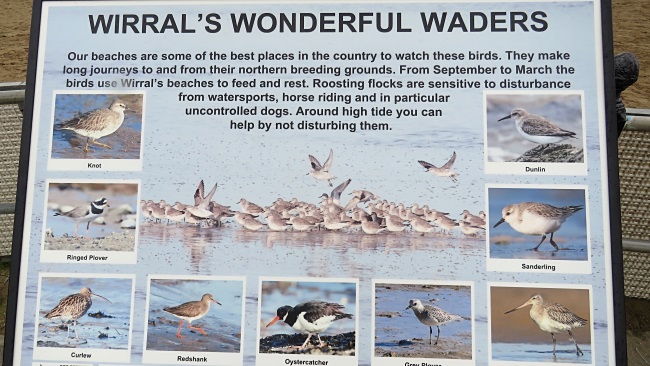
The sign was put up on behalf of the Dee Estuary Voluntary Wardens and funded by the Burbo Bank Extension Community Fund.
Top of Page
What to expect in July

At Gronant the young Little Terns will be fledging, and also, around the third week in July, we get an influx of adults from other Irish Sea colonies making a total of between 500 and 800 - an amazing sight (see the May 2017 Newsletter for further details about the Little Terns).
By the end of the month we can not only get good numbers of terns on our beaches at high tide (including Common) but also many hundreds of gulls - of particular interest are Mediterranean Gulls which are still relatively scarce in our area - although they do breed in Cheshire.
Harassing the terns and gulls as they feed over the sea may well be a selection of skuas, with Arctic Skuas always the most likely. A fresh south-westerly should bring in good numbers of Gannets and Manx Shearwaters, and may be the much harder to spot Storm Petrel.
In the estuary and adjoining fresh water sites numbers of waders will rapidly increase - as well as the commoner waders such as Redshank and Curlews look out for Greenshank, Spotted Redshank, Whimbrel, Common Sandpiper, Green Sandpiper and Wood Sandpiper. Black-tailed Godwits will return from Iceland still in their full breeding plumage. Unfortunately the Gilroy Scrape* is still empty but other fresh water sites may hold several hundred, especially Burton Mere Wetlands.
There will be plenty of other birds around but most will be secretive with young, adult Cuckoos will most probably have already left for Africa but the juvenile birds are fairly easy to spot and sometimes give good photo opportunities.
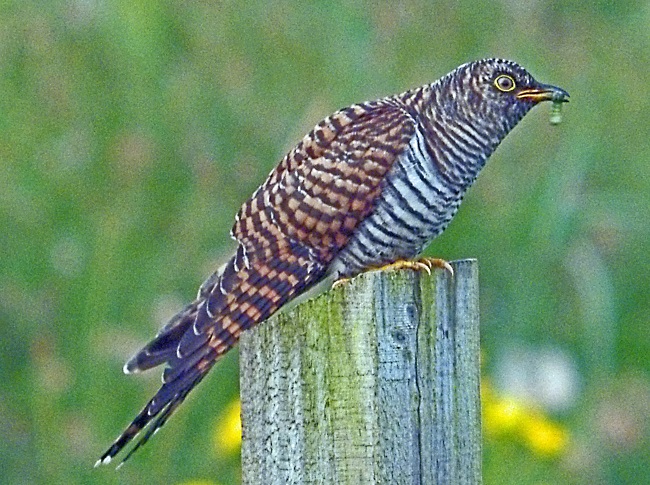
* At the time of writing there is still some hope that the Gilroy Scrape at West Kirby will be restored, although it is increasingly worrying that the process is taking so long and it is certainly possible that we have lost this site which has been Internationally Important for Black-tailed Godwits for several years.
Top of Page
Forthcoming Events
July Highest Spring Tides (Liverpool)
Also
see Tides
page.
23rd July, 11.45hrs (BST), 9.5m.
24th July, 12.35hrs (BST), 9.6m.
25th July, 13.22hrs (BST), 9.6m.
Forthcoming Events
Organised by the Wirral
Ranger Service , Flintshire
Countryside Service and the
RSPB (Dee Estuary):
All these events and walks have bird interest, even those not
advertised specifically for birdwatching. No need to book for these
events unless specified - please check below.
1 pm start.
Price: Free (normal reserve entry charges apply to non-members).
Join
one of our friendly, knowledgeable volunteers for a leisurely amble
around much of Burton Mere Wetlands, including the unmissable viewpoint
at the end of the Hillfort Trail on Burton Point. Take in the sights
and sounds, learn more about the wildlife that thrives here, the work
we do to give nature a home and the remarkable history of the estuary.
Great
for first time visitors or those looking to brush up on their
identification skills; with constant changes as we move through the
seasons, it's impossible to predict what might be seen. Summer may be a
quieter time for birds since they finish defending territories as
breeding season ends, but the growing avocet chicks and fledged little
egrets and herons loafing close to the hides are great to watch. Warm
sunny days will bring out the various dragon and damselflies that make
their home on the reserve, along with butterflies and basking common
lizards! Some birds begin their return migration just as we are getting
settled into summer so sometimes unexpected birds may be found.
No
booking required, just turn up on the day. A reasonable level of
fitness and sturdy footwear are required. Walks typically last up to 3
hours, weather permitting.
Ring 0151 353 8478 for further details.
10am to Noon.
Join
the Wardens on a guided walk of the Little Tern Colony at Gronant Sand
Dunes and learn all about these fascinating seabirds. Bring sturdy
shoes or boots, Gronant sand dunes are exposed to the weather coming
off Liverpool Bay so bring suitable clothing.
Meet at the car park opposite the
Crofter’s Cafe on Shore Road, Gronant.
This event is free and no need to book, for further details ring 01352
810614
or 01745 356197.